Text
We Moved!
24 January 2019
We are now blogging at https://medium.com/designinghumanservices. Thanks for reading some of our 42 posts over five years.
We’ll leave our last post here with a link to reflections on creating an internal design unit in a municipal agency.
Hope to see you on Medium! Feel free to reach out with any questions: marc (dot) hebert (at) sfgov (dot) org.
1 note
·
View note
Text
Stories Matter
18 September 2018

Source: Archives New Zealand, Flickr
I’ve shared stories about my lessons learned trying to champion service and systems design from the Agency’s Innovation Office. Over time, several folks have responded to how these stories have resonated with them. None have been so heartfelt in reflecting back to me as the following. Note: Personally identifiable information has been removed.
“[...] as the head of [Customer] Experience, my mission was to understand the components lying beneath great Experiences and make them available to the business units in order to enhance their performance. Until I saw your 35-minute video, I spent 2 years with my enthusiasm and passion trying to convince people to implement the great ideas we had (and we even had proof that they worked and enhanced the performance significantly with precise KPIs), organizing workshops, trainings, etc. After two years, we had some successes but they were too few and I had to acknowledge that some business units had not embarked in the change we were supposed to initiate. I thought that, with a 'proof of concept', other business unit managers who were reluctant (or didn't like me - a factor I had not considered at all in our success / failure and that is MEGA important) would immediately see the added value for their business and would jump on the boat. It didn't happen at all. We were still considered as the guys who were cute trying to bring this new [Customer] Experience thing 'But hey, we are so busy and you can't compare us to the business units who worked with you and obtained results: we are different!'
Then I saw your video that was describing my life...After 35 minutes, I called my team, told them to stop whatever project they were working on and told them that from now on, we would stop selling great ideas because: 1- people were not interested in good ideas 2- our ideas could send the message that they had been incompetent until now 3- our way to bring change was not efficient. Instead, I told them that they needed to start clean with a meeting where we would listen to the problems and challenges of people and where we would offer our support wherever our competence could help them fix their issues. It was not anymore about communicating how good we we were at bringing value to the business units. It was about listening to people and their challenges and putting our brains and competencies at work to solve issues, nothing more.
Everyone started to book meetings with the managers they were working with. We were surprised to see people sharing their issues so openly. With all the problems in mind, it was easy for us to offer solutions or orient the managers towards the right people in the Group if we were not competent to help. The two last years of our division have been incredibly successful and we became real internal partners instead of bothering people with our ideas [...]”
What about you? Whose stories have shaped your thinking? Have you reached out to let them know their words have mattered to you? Feel free to let us know: marc (dot) hebert (at) sfgov (dot) org or if you’re at the Municipal Innovators Conference this week then let’s connect there.
2 notes
·
View notes
Text
Behavioral Insights/Economics
26 June 2018

Source: Gadjo_Niglo, Flickr
Rather than writing a super long post about all the stuff we’ve been up to since we last posted (which has been too long)...we are going to chunk some of our updates. If we keep them small enough to do in a day then they’ll get done, right?
Let’s start by sharing some of our behavioral economics/insights work.
We were asked by one program in the Agency to increase “show rates” of clients to a particular appointment. Previously, we tested text messages with clients, and had data about which message to send. We then worked with this program and a team of analysts to select at random group of around 600 clients who opted in to receive text message communication.
More than half of these clients were chosen to receive a text message 24 hours before their appointment and the remaining were not. Unfortunately, we couldn’t split the populations into 300 each. We ran this test for two weeks each day. The results showed a 39% increase in the show rates for clients who were texted.
The pilot lead the program to work with the vendor who created its scheduling software to start building a text message reminder system. One of the managers in this program learned that this would take awhile and wanted to help clients sooner. So, this person worked with their team to create a technological workaround to allow employees to text clients appointment reminders. They reported a 40%+ increase in their show rate.
We also spent a couple months trying to understand how different parts of our 2,400+ person Agency text clients through nearly two-dozen programs. We learned there is no centralized approach, messaging templates or metric of the impact of every message. We worked many stakeholders to develop a strategy and are in the early phases of implementing it.
Finally, another program in the Agency asked for help earlier this year with an outreach campaign that had two goals: (1) nudge 60,000+, lower-income San Franciscans towards free tax prep assistance instead of them paying for it. (2) Help them save as much as possible in tax credits.
Given the constraints of this project, we had to mail clients, and were unable to measure if each person who receives a letter goes to a free tax site. We also didn’t have time to do a text messaging campaign this year that would have helped with measuring impact.
In partnership with this program manager, we did the following:
1) Reduced the original 11-page mailer to four pages (two pieces of paper double-sided).
1) The first double-sided page informs the recipient who is contacting them, why, the number of people who received free tax help last year, and how much they saved in taxes. We then asked them to present the back of this slip of paper to their tax preparer. The back requests the tax preparer to look at four tax credits that total nearly $10,000.
2) The second double-sided page in the mailer is a checklist of what someone should bring with them when they file their taxes. The other side of this page includes about 20 places/times/hours people can go to file for free. Unfortunately, we were unable to include a map, which research has show helps.
We did learn that more people received free tax prep this year than last year, but “correlation isn’t causation,” right?
How are you using behavioral insights / economics in your work? We welcome feedback at marc (dot) hebert (at) sfgov (dot) org.
0 notes
Text
Creating an Innovation Lab in Your Organization?
Someone called to chat last month about creating an innovation lab in their organization. Here are some paraphrases and additional thoughts from the conversation that may help others.

Source: InnovationNorway @ Stanford d.School, Flickr
Q: We’re thinking of creating a space where people can come to bounce ideas off of us. Yes, it’s somewhat vague, but we want a place in our organization where this can happen, and where we can be available to anyone looking for creative problem-solving.
A: Your instinct is right about being able to help people as they need it. Yes, having a physical space where people can come and whiteboard ideas and sticky note possibilities is critical. It lets them know that they’re entering a place where a different mindset for problem-solving is welcome. But I’ve found internal innovation labs can be largely focused on problem exploration and definition. While prototyping may also occur in your new space, testing, iteration, implementation and evaluation may not be happening there. This means follow-up is critical after people visit your space. How might you help them to follow through?
We were unsuccessful in championing an educational-based approach to innovation (teaching people Human-Centered Design, design strategy, Lean Process Improvement, Behavioral Insights/Economics, visual facilitation, etc.). We were much more successful when people had a specific problem, and we used those techniques to address their immediate needs.
The daily urgencies that colleagues experience mean we need to help them now. So include educational opportunities for them as the process unfolds (e.g., templates, How To instructions, videos, books, etc), but don’t make it the primary objective. Consider that they may return for more assistance after having experienced your warmth and value. Then you can focus more on them learning your innovator’s mindset and toolkit.

Source: musicisentropy, Flickr
Q: What are the metrics you use to evaluate success?
A: It depends on the purpose of the internal innovation lab or space you’re creating. Our purpose is to improve how clients, community partners and employees experience service delivery. The strategy is to use service design. The intention is to make the work of the Agency more effective.
Our success metrics include “How much/many did we do? How well did we do it? How is anyone better off?” (based on the work of Mark Friedman, Trying Hard Isn’t Good Enough, who created Results-Based Accountability). It can be tough to account for everything we do this way, but we try.
We’re now in the process of following up with some people, 6 - 12 months after working together, in order to learn about our impact. Their stories will hopefully be a future blog post.
Speaking of stories, qualitative data is important when measuring impact. Stories and visuals of people understanding the problem and experimenting with solutions are powerful. Document and photograph as this work unfolds (be sure to ask people for their permission, letting them know how the info may be used).

Source: Sea Turtle, Flickr
Q: Any other advice?
A: Besides not feeding giant scorpions? Yes!
- Who are your internal sponsors especially at the executive level?
- Staffing and budget requirements? There are likely no shortage of creative and innovative people where you are. How might you honor the work they have already done, frame this initiative within a history of being in an innovative organization, and identify them and others as champions of your work? An annual celebration of innovative work may be one approach as well as an ongoing newsletter or blog.
- Who are the other stakeholders of this initiative? How might their voices be included in its creation and ongoing success? What might “co-creation” with these stakeholders look like at different phases of developing and sustaining your innovation lab?
- What is the north star or guiding orientation for your innovation lab (e.g., measurably improve how clients, employees and community partners experience service delivery)?
- Are there principles or a “playbook” that you and others could follow that would help you head towards this north star? These would serve as guidelines for behavior and language to create team norms (e.g., Focus on user needs. Be explicit about assumptions and question them. Design for mobile experiences)?
- Do you have a “Theory of Change” or game plan for producing and measuring results in the coming months and years? Does the plan include quick wins? Will others easily understand your plan? The sooner you get to prototyping possible solutions with people who want your help then the sooner you’re creating outputs and impact in your organization. See more about strategy here.
- What are you calling yourselves? How are you explaining your call to action? We first described ourselves as a “Learning Lab.” Our coworkers understood our mission was training, not working with them to solve problems. We then became known as the Agency’s “Innovation Office,” and now they ask how we (not themselves or colleagues) are innovating the Agency. Your name should communicate your mission and how it is dependent on everyone together, not just you. It took us a looooong time to create a simple infographic with less than 15 words to explain who were are, what we do and why.
Feel free to email me at marc (dot) hebert (at) sfgov.org for any questions. Our lessons learned are many so we’re happy to help.
4 notes
·
View notes
Text
From Add-on to Integral
We’ve had the opportunity to share with several folks about our failures, successes and the important learnings in-between. Described below is a mental model we’ve shared with colleagues at the local and federal levels as well as abroad.
It helps us to reflect on our lessons learned and to be more effective in the way we champion service design thinking and doing.
Let’s call it the Add-on to Integral Scale.

Source: Christopher Rose, Flickr
Much of the work we do is to help people with their immediate needs or urgencies. The metaphorical fires burning employees’ time and efforts need to be put out ASAP.
How to meet their immediate needs while also building the needed internal capacity for employees to see the smoke and prevent the flames from occurring?
Enter the Add-on to Integral Scale.
Integral = an easy and effective “hack” on a process that employees will be doing anyway, like thinking about a problem, planning for a project or trying to make something better.
Add-on = additional steps employees have to take; typically introduced through a formal learning experience (classroom) where the value is not immediately apparent to change their behavior/process.
We’ve found that any mindset or method introduced to employees is commonly seen as an add-or additional to their job.
Why? Because most have action-packed days. They feel stretched. Anything seen as additional that doesn’t provide immediate value to help them, coworkers or the public will not likely be used.
This is why we do not recommend an educational-based approach to champion innovation or service design thinking and doing in government unless it is tied directly to current pain-points experienced by employees or the people we serve.
We’ve found the educational-based approach falls short when there is no ecosystem in place to encourage creative and effective problem-solving or continuous improvement.
Admittedly, there are outliers, including Denver Peak Academy or perhaps they had the skeleton of an ecosystem in place when starting?
How could we change the way people see a new method or process from being an add-on to their work to being integral? Here are three things that’ve worked for us: (1) mindsets, (2) premortems and (3) prototypes.

Source: Steve Davis, Flickr
We assume that everyone needs to think about solving a problem or making a decision. So thinking is not an add-on. We’re just asking them to do it slightly differently.
To do this we are experimenting with championing the WRAP process developed by the Heath brothers in their 2013 book Decisive.
WRAP = Widen Options, Reality-Test Assumptions, Assume Distance and Prepare to be wrong.
Practitioners of Human-Centered Design, Lean Startup, Lean Process Improvement and Behavioral Economics will see elements of these practices when unraveling WRAP. We’ve also drawn from these areas to create our own version.
We encourage employees to start using one or two parts of the WRAP process and then, depending on the problem, consider working through the whole thing.
Widening Options can be pretty easily tied to Reality-Testing Assumptions when people ask themselves or their team:
“Is anything missing?” or
“What else could we do?” or even saying,
“Show me,” (Ashton 2015:198) rather than dismissing another’s idea.
When folks find something we’ve shared valuable, then they use it. Some come back for more help, and are willing to test additional processes to improve service delivery.
The last post on this blog talked about the Agency’s HR Improvement Movement, and how some units made more changes than others. It’s my hunch that part of this was because I didn’t focus on mindsets enough as a easier way for HR employees to integrate service design in their work.
WRAP is a lightweight version of introducing Human-Centered Design or Lean Process Improvement. If employees find they can move from “either/or” statements with only two choices to finding alternative possibilities by using “yes, and” then we can build on that into more sophisticated techniques.
Another method we’ve found people to see as integral is the premortem.

Source: Freaktography, Flickr
A “premortem” might sound like a “post-mortem” or something yucky that happens in a hospital. They are both learning opportunities though premortems don’t require medical training.
I’ve already written in detail how to do it. Briefly, imagine a project or decision is done, and then think aloud:
Wow! That was an epic failure. Identify all the factors that contributed to making it fail.
Then imagine the project was an amazing success. List all the factors that contributed to its success.
Finally, plan the next steps to reduce the failure factors and increase the ones that lead to success.
Project planning, like thinking about a problem, is going to happen anyway so premortems and WRAP can fit within employees’ existing work processes.
Prototypes are the third method we’ve seen that help us slide down the Add-on to Integral Scale to champion service design in the Agency.

Source: Marc Hebert. Face icons courtesy of Anselm Bradford.
The above glare-filled photo is from an Agency lobby. We’ve been prototyping a feedback wall to help us understand the right location, types of questions asked as well as the process for creating effective, client feedback loops.
Prototypes are rough drafts or simulations that are quicker and cheaper than creating a finished thing (e.g., document, plan, process, service, etc). They provide helpful insights and test assumptions when creating or implementing just about anything.
Let’s be clear; even creating a rough draft of something can be an additional step. But people are willing to take this step if they see the potential payoff from the start. Value perception helps to reorder people’s mental model of what is an “add-on” to their work, and instead view it as “integral.”
For example, a colleague in one of the Agency’s programs wanted to print 1,000 handouts to give clients. I suggested showing clients a rough draft before printing all of them. My colleague immediately recognized the value in this, and was willing to prototype in order to make the final version more helpful for clients.
Prototypes:
enable employees to see immediately how things could be better, what’s not working, and why,
give people something to respond to,
can result from a curious colleague or boss saying “show me” to an idea,
Mindsets, premortems and prototoypes help us champion coworkers’ mental models to see these tools as more integral than additional to their existing work processes.
We will continue to experiment with ways to use the Add-on to Integral Scale as we keep trying to improve our services.
Feel free to share your thoughts or tips to getting to integral with your teams: Marc (dot) Hebert (at) sfgov (dot) com.
0 notes
Text
Service Design in HR: Wrap up

Source: Weekend Knitter, Flickr
It’s been three months since 14 employees (all non-managers) had their last service design workshop.
They completed several questionnaires on the whys and whats of their collective outputs (How much was done?) and outcomes (How is anyone better off?). Here’s an overview.
Participants’ Key Learnings:
Prototyping (giving people something to respond to, gaining insights early and quickly in a task or project).
Developing a process to make improvements.
Including improvement process into a daily routine.
Small win + small win = big change
Working with supervisors to standardize their / our work.
Asking for feedback on ideas is important.
Just Do It (experiment with making an improvement quickly).
We can’t control everything in the process.
Need to follow up with people.
Obstacles Experienced:
Motivating others to join/innovate/make stuff better.
Momentum.
Measuring effectiveness.
Reaching agreement.
Prototyping.

Source: Mendolus Shank, Flickr
How much was done? How is anyone better off?
1) The Payroll error rate (including errors from non-Payroll employees and managers submitting their time sheets incorrectly) went from 1.06% before the nine-week, HR Improvement Movement to 0.87% afterward.
2) Supervisors from two separate units, Payroll and Operations, meet monthly and send notes/next steps of their meetings to their respective teams, improving communication and transparency. They were not formally meeting to coordinate processes before this change.
They clarified division of duties, reducing communication silos between two units, helping to improve workload imbalances.
3) The Payroll supervisor created an open-door policy and invited feedback to improve processes, which staff are now using.
For example, Payroll needed a new printer, employees shared their concerns with their supervisor who submitted an IT request, and received a new printer in 24 hours. Shout out to IT for making this happen so fast!
4) Payroll unit meetings had low participation, sometimes the meeting rooms weren’t reserved and meetings went overtime. Employees submitted suggestions anonymously to their supervisor to improve the meetings. Changes included:
Double-checking that the meeting room is reserved.
Everyone gets a chance to facilitate or speak during the meeting.
There is a timekeeper so meetings now end on time.
5) Payroll supervisors created a daily checklist of tasks that all employees do.
This helped everyone to know what is needed of them each day, improving clarity and accountability.
The checklist is on the shared drive and printed out and given to everyone daily.
6) The head Payroll supervisor standardized submission requirements for all programs to email time time sheets.
Before: Programs would send a fax, email, use interoffice mail to send the original time sheet to Payroll. Programs would also photocopy the original for their records.
After: Programs keep the original and email a copy to Payroll.
Update! Payroll is moving the entire agency to an online timesheet process.
7) Payroll supervisors provided their team with a one-page overview of the most common codes to complete a time sheet.
Payroll employees no longer call Program supervisors and managers to explain the codes. Instead, they send them this sheet.
Payroll employees are also using this sheet to fill in the information.
8) The Exams unit launched a monthly, cross-unit potluck that continues to be well attended.
9) Exams and Operations created a kudos board where employees and their supervisors and managers acknowledge each other’s efforts.
10) Operations lead an effort to help HR employees eat more healthily using an application developed by the City’s Health Service System.
11) The Labor Relations unit started a birthday potluck.
13) The Learning and Development unit formed a “Random Acts of Kindness” group where 40+ HR employees are doing random, anonymous, acts of kinds for each other.
14) They created an hour-long training for supervisors and managers to improve the way they provide feedback to their teams. They prototoyped it in another program and plan to test their second iteration next month in HR.
15) They also launched an HR-wide newsletter to provide updates across the units, introduce new employees, and clarify strategic objectives from the HR Director.

Source: Tanel Teemusk, Flickr
How well did we do these service design workshop? (Friedman 2015:80)
In terms of feedback, 10 of the 14 participants rated us on a three-point scale (sad face, neutral face, happy face designed by @anselmbradford ).

We asked three quantitative questions:
1) How satisfied are you with yourself in the way you've applied the Innovation Process (empathy + experimentation + evaluation) in the past two months?
7/10 = Happy Face, 3/10 Neutral Face
2) How was your overall experience participating in the workshops?
5/10 Happy Face, 5/10 Neutral Face
3) Would you recommend the workshops to others?
7/10 Happy Face, 3/10 Neutral Face
We also asked opened-ended questions (some of the results were reported at the top of this post).

Source: Jeremy Brooks, Flickr
Reflections on the Experience
Readers of the early blog posts will know that an educational-based approached of training employees how to prototype, test their assumptions and constantly trying to improve service delivery is much more effective when tied to specific “pain points” employees (and the people we serve) are experiencing.
So why did Payroll make so many improvements, quantitatively and qualitatively?
We asked this question of the group and the responses varied. Some said their units had different types of problems than Payroll so they couldn’t apply the toolkit similarly or as effectively.
Others said their unit was not as willing to make changes.
Still others said everything was fine in their unit, but when pressed could find areas for improvement.
The group also acknowledged that one of our members from Payroll was really engaged with what we were doing, and used the toolkit effectively with the help of the rest of the Payroll unit.
So to what degree are these results based on the structure/system/environment vs. individual grit and determination? It’s a mix of the two plus other factors and questions....
...including, what was my role in not have similar outcomes across all the units? I plan to answer these last two questions in my next post.

Source: Duluoz Cats, Flickr
Next Steps
Our time together ended with each participant presently briefly on their accomplishments and reflections in front of their supervisors and the HR Director.
We appreciated them there and at a celebration later that included a framed word cloud filled with positive attributes of each participant as described by their boss.
Since then, I’ve been working with HR managers and supervisors to champion a newer iteration of what we shared with the original HR Improvement Movement group.
More to come on this later.
We’re open to feedback and ideas: marc (dot) hebert (at) sfgov (dot) org.
0 notes
Text
Service Design in HR, Pt. 2

Source: Pascal Bovet, Flickr
Time is zipping by! We’re finishing week five of nine of the Improvement Movement in HR where 14 HR employees (we’re down by two) practice/learn service design techniques by applying them to projects to improve how coworkers or clients experience service delivery.
Week one was co-creating with them our plan for what we were going to do and how. Week two focused on the double-diamond design process as a supplement to our service design guide. We also introduced an online spreadsheet where they described their respective project(s), who else is working with them, and what “success” looks like.
Week three was a turning point. The double-diamond wasn’t resonating with them. My co-facilitator at these workshops and Organizational Development Specialist, Ellen Steinlein, asked me to try another way to explain it. I’ll get to that below, but in the mean time, she also recommended setting up time to coach them on their projects mid-week for 10 - 20 minutes. We split the group in half and each of us listened to their concerns and experiences with applying service design concepts.

Source: Elycefeliz, Flickr
Listening to them and asking clarifying questions seemed to help. Some said they saved a lot of time trying to figure out how to apply service design to their respective projects because of our meetings. Others shared how they now have a greater sense of clarity around the meaning of “iteration” and “prototyping” and its role in the process to improve clients’ and employees’ experiences. The insights from these coaching sessions made me wish I had done them earlier in other projects.
Experience is something you don’t get until just after you need it. ~Steven Wright
In week four, they learned how to do a premortem. You might know about a postmortem from watching those doctor shows. All the medical staff who interacted with a former patient gather together after this person dies in the hospital to discuss what happened. Our approach to a premortem is discussing what went wrong (and right) with a project before it’s done by doing a thought experiment.

Source: Clem Whitt, Flickr
There are different ways to do this thought experiment popularized by Daniel Kahneman in his book Thinking Fast and Slow. The version we use has been influenced by Kahneman as well as Cass Sunstein in his book Wiser, and also the Health brothers in their book Decisive, among other resources.
We’ve used the following version of the premortem with colleagues in and out of the Agency for many months now to help them craft a better strategy for their projects.
Here’s how we do it:
1) Gather your team together (everyone or position touching the project). I’ve also done a premortem with Agency executives around a big project to be sure the team understood their expectations.
2) Ask everyone in the room to imagine it’s the future, and the project you’re working on is done. Unfortunately, it’s been an epic failure. Ask them to list all the reasons why it failed. They should use the past tense of verbs not the present tense.
3) When done, prompt them to give more responses by saying, “Anything missing?” then wait a moment or two for them to share other ideas, and then prompt them again by asking: “Can you go through the alphabet from A to Z in your mind to trigger anything else to put on this list.”
An additional prompt was used during a premortem yesterday: “What would your boss say if s/he was here?” This generated what sounded like the most important potential failure on the group’s list: “The project did not answer the right question.”
Next, write all their answers on the far left-side of a large whiteboard under an “Epic Failure” heading. Alternatively, people can write their responses on easel paper (use the non-sticky kind so they can roll it up and take it back to their office afterward).
4) Repeat #2 & #3 above, but this time ask them to imagine after they implemented their project it was an “Amazing Success.” Write responses for what the group did to make it so amazing on the far right-side of the whiteboard or on a separate piece of easel paper. Use the same prompts to catch blind spots.
5) Now ask, “What can we do today to reduce the chances of failure?” Write responses in the middle of the whiteboard or a separate piece of easel paper. Then ask, “”How can we increase the likelihood of success?” That’s it! Let us know if and how you use it (Marc at Hebert dot sfgov.org).

Source: Guilherme Cardoso, Flickr
Returning back to our weekly, two-hour gatherings for championing service design. When we met on Monday of this week, all the managers and supervisors in HR were invited to attend the first hour to see prototypes of the improvements that the group is making, and to ask questions. Everyone spoke briefly. In a short amount of time, they all knew what each other were doing and the managers and supervisors were even talking about tweaking some projects for cross-unit collaborations.
Once the first hour was up the managers and supervisors left. In the second hour, we revisited our approach to service design:
Service Design = Empathy + Experimentation + Evaluation.
As mentioned above, explaining the design process using the “double diamond” was not something our participants identified with. So we decided to just dive deeper into our definition of service design as way for them to clarify to themselves what it is we’re doing and how we’re doing it.
We know from educational research that when people create their own way to explain things then they can own it, and can share these new ideas with other people at some depth. If we want to spread service design in a division or organization then this is an important part of our strategy. So, we asked the workshop participants to practice talking about doing service design using a tried a true learning tool called “Think, Pair, Share.”
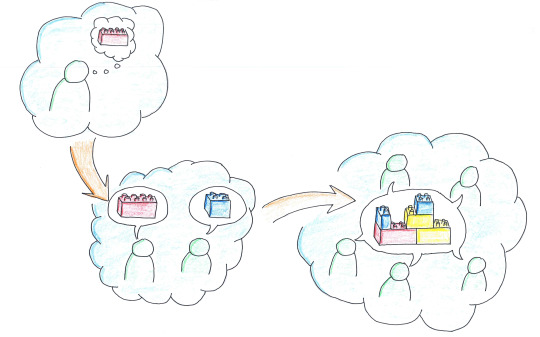
Source: Oliver Tacke, Flickr
Just like the visual above shows: we gave the group time to think individually about how to explain the definition and process of service design. Then they each shared their thoughts with a partner for a couple minutes, switched roles, and finally their was a group discussion.
The discussion helped clarify that they don’t necessarily need to follow a sequential order of first empathizing, then experimenting and finally evaluating, but rather they can adjust to whatever mode of thinking and doing is most relevant. They just need to be sure to do all three when needed, and most likely multiple times (iteratively).
That’s all for today. If you haven’t seen Ellen’s blog posts on doing Service Design in HR then check them out here.
As always, please send comments and questions to Marc (dot) Hebert (at) sfgov.org.
0 notes
Text
Service Design Workshops in HR
The Agency has a team of organizational development experts led by Ellen Steinlein, who is collaborating with the Innovation Office to co-facilitate a nine-week series of service design workshops for 16 HR employees.
Service Design = a creative approach to work with not just for others to improve how people experience services (internal or public-facing process), employee life (appreciation, morale, professional development, etc.), things (forms, charts, signs, data, etc.), and spaces (offices, hallways, cubicles, walls, lobbies, etc). This short video is a great introduction to service design.
The purpose of the nine-week workshop is to champion the improvement movement in HR as part of an ongoing effort to enable each employee to innovate service delivery. HR is so important to the work of the Agency that having people continuously try to make stuff better could benefit thousands of employees and even more in the great public we serve.
Back to day one of the workshop. We kicked it off by explaining “design” means more than fashion and style created by some genius.

Source: Ashton, Flickr
For us, design = a creative, repetitive (iterative) process anyone can do by focusing on people’s pain-points, needs and feedback. This is called “human-centered design” and it’s done like this:

Source: The Double Diamond model by the UK Design Council courtesy of Rachel Reynard.
Looking above, “<” means widening options and possibilities, like discovering the problem or developing solutions.
“>” means narrowing options and possibilities, this happens when defining the problem and delivering solutions.
The above model is good to organize our thoughts, but we need a simple, step-by-step guide to do service design. Well...we’ve got one for you (click here to download it). If a box pops up on your screen, then just click the “X” in the top right corner of the box and it should close.
We shared the one-page guide with everyone in the room on April 18th and explained how this experimental and iterative (repetitive) process works.
We then tried to get everyone on the same page of what we would do and how by creating a game plan for the nine-week workshop series (shown below).
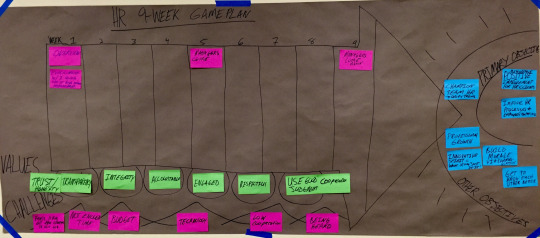
Source: Marc Hebert, This is a template from David Sibbet’s Visual Meetings (2010).
On the far right is a giant target:
Primary objectives (inner circle in blue) = measurably improving clients and employees experiences with service delivery.
Other objectives (outer circle in blue) = champion a unified HR team, build morale, get to know each other better and professional growth,
Challenges (starting on the bottom, far left in pink) = the visual is of mountains we may need to climb, including feeling that all the changes are the responsibility of the group of 16 (they’re not), not having enough time, no budget to make changes, low transparency, low cooperation, and not being heard.
Values (green, wheels carrying the giant arrow/strategy) = trust/honesty, integrity, accountable, engaged, respectful, use good judgment and cooperation.
The 9-Week Strategy is divided into nine columns (in pink). Week 1 includes an overview and challenge to experiment with one improvement following the service design guide. Week 5 and 9 will be a visit from the managers to share what the group has done and to ask for any help if needed. We plan to fill each column weekly.

Source: Marc Hebert
We then teased out the roots of the problem surrounding communication, specifically the obstacles to communication experienced by HR employees.
We then brainstormed solutions to these obstacles that produced non-actionable ideas like “listen” and turned it into “managers should provide ten minutes each meeting to just listen to staff.” Because of that some numbers are missing on the Importance-Difficulty Matrix (see below) we used to prioritize these possible improvements.
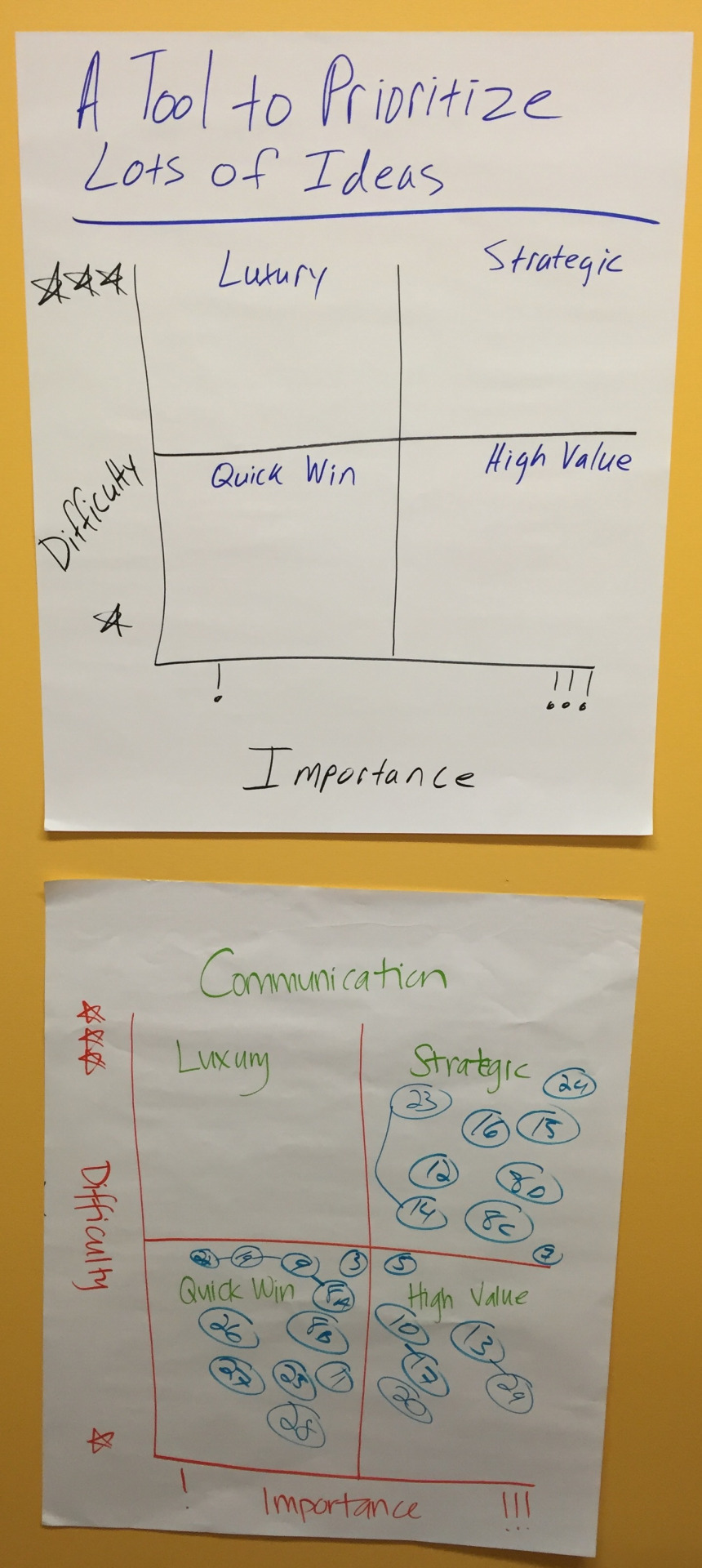
Source: Marc Hebert
The group then chose the quick wins or high value improvements they wanted to experiment with this week following the service design guide. They are free to collaborate rather than choosing one project per person. We plan to see what their experiences are next week after making at least one iteration with trying to experiment with an improvement.
3 notes
·
View notes
Text
SCIP Reflections & Next Steps
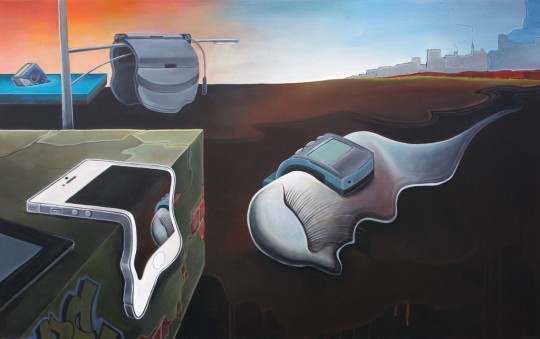
Source: Gallerie Michael, Homage to Salvador Dali
Five months have past since our last update on the Service Center Improvement Project (SCIP). Yikes! To get you caught up, we started in April 2015 with 38 people from a dozen different programs (e.g., CalFresh, In-Home Support Service, etc.) and seven different positions/professional perspectives (e.g., Clerks, Eligibility and Intake Workers, Supervisors, Managers, etc.).
When we finished our six-month experiment in September 2015 with about the same number of people when we started (though a couple of folks came and went) the group had created 96 SMART plans to make bite-sized improvements (taking minutes, hours or a full day’s worth of time). They implemented 83% of these plans. The outcomes of some of their improvements included the following:
- Reduced CalWORKS clients’ wait times on the phones (by 66%) and in the lobby (by 25%) at 170 Otis St.
- Reduced Medi-Cal clients’ wait times in the lobby (by 71%) at 1440 Harrison St.
- Reduced by two days the amount of time it takes to process paperwork in the In-Home Support Services Program.
- Created Kudos Boards (where employees publicly write appreciation for one another and post thank you cards from clients) in 170 Otis St., 1235 Mission St. and 1440 Harrison St.
- Conducted a retreat for staff from three separate programs prior to merging at a new one-stop service center for seniors and adults with physical impairments.
We celebrated these accomplishments (the cake took a wee bit of beating on the way to the room but it’s cream cheese frosting did not disappoint.)

Source: Marc’s cell phone.
Then we reflected and debriefed with the SCIP participants. Here’s what we heard, from the non-managers (i.e., those who created and implement nearly all of the plans since it was supposed to be driven by them).
- Learned a lot.
- Had fun.
- Felt it was mostly us doing the work without a lot of help from colleagues.
What do these data tell us if we...

First, non-managers expressed being burned out. No one can blame them. Supervisors in particular were not given time off to work on SCIP so their workload at times was a lot. That’s not good. Employees shouldn’t feel penalized for wanting to improve service delivery or clients’ experiences.
Second, the non-managers in most of the programs said that only few of their coworkers were helping them. Why is that? Several possible reasons, including that the Agency serves people who are in crisis. Crises can create a sense of urgency. It is understandable to view time spent any other way as being less urgent, such as on SCIP/improving service delivery.
Third, the non-managers who participated in SCIP overwhelmingly told us months and weeks before the six-month experiment ended that they wanted to continue meeting monthly. The purpose was to share ideas, breaking through organizational silos, and keep making stuff better. They expressed a sense of camaraderie and sought to keep this going. Since SCIP finished we continue to meet monthly, but only about five or six of these two-dozen folks come.
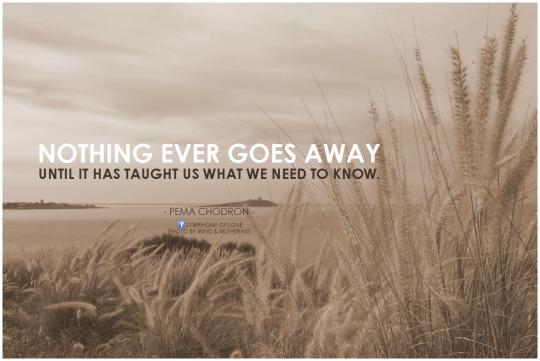
Source: BK, Flickr.
Lesson Learned #1: To paraphrase the Heath brothers in Decisive: Urgency can crowd out priorities (2013, pg. 187). Urgency can also crowd out any strategy or long-term plan that does not overlap with employees’ perception of the daily tasks that need to be done. We also know that how employees view the existing evaluative and reward structures of their work shapes their behavior. The evaluative and reward techniques we used did not shift the existing structures or cultural practices to reward and evaluative employees.
Lessons Learned #2: Provide better capacity, structure and support to employees when championing them to make stuff better for clients, coworkers and themselves.
Lessons Learned #3: Just because employees are working a lot on what might appear to be something less urgent they can still have fun and learn a lot. This provides both hope for continuing to better our programs as well as inspiration from the Agency having incredible people doing their best given their constraints.
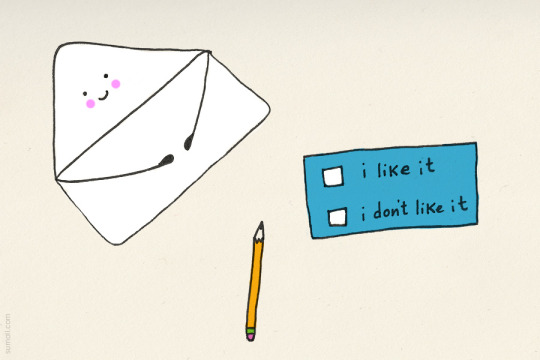
Source: SumAll, Flickr
Besides asking non-mangers for feedback, we also asked it from their program directors who also participated in SCIP. Here’s what we heard:
- Things are currently going so well in our program that we no longer need any structure (i.e., SCIP) to sustain this because employees will likely keep the improvements going.
- We’ve been making improvement all long so participating in SCIP wasn’t necessary for our program.
- We don’t have time to keep participating in SCIP.
- Why don’t we focus on one ambitious goal moving forward that is of great strategic value to our clients and us rather than on many of these goals?
- The SCIP process does not help us work on big projects.
What do you make of these findings? There doesn’t appears to be clear consensus. Maybe each saw varying levels of utility and purpose in having their staff participate? Maybe the current legal mandates and sense of urgency across these programs created constraints that SCIP did not appear to be helping.
All of these may be true, and I think the biggest factor for their understandable push-back was not inviting all the middle managers (section managers and supervisors) in every program that participated in SCIP for their feedback before, during and after the pilot.

Source: LeaderLab, Flickr
Lessons Learned #4: Organizational hierarchy/structure does not (maybe should not) mirror it’s communication structure (Sheridan:2013). Sometimes most employees understand a message shared among them, and others times not. I certainly don’t understand everything I’m told. Even though every one in each of the programs that participated in SCIP was supposed to have received a presentation by their colleagues explaining SCIP, this was not effective.
I trusted the hierarchy would work to communicate the message. Instead it was like the children’s game “telephone” where a group of people sit in a circle; one person whispers a message in someone’s ear and as the message is passed from person to person the last person says aloud what s/he heard. Often what is announced is not what the first person said. This happened to us.

Source: ElizaC3, Flickr
By not engaging middle management (i.e., section managers and supervisors) early and often, they were not in a position to fully understand SCIP, question it, make it better and when done be in a position to support it.
Where does that leave us? Well, we are continuing SCIP 2.0 in two of the service centers. This time, I’m meeting with section managers and supervisors in both buildings, asking for their feedback on SCIP 1.0 as well as 2.0. This includes understanding the best way to communicate with them and how often about our next steps.
SCIP involved four service centers: One was in the process of being created and the other three had been around a long time. Two of the buildings that historically provided either Medi-Cal (Medicaid) or CalFresh (food stamps) have made great strides recently to integrate. This means clients can receive services for both programs in both buildings. I’m assisting with integration, using our service design/innovation process. It’s not SCIP per say, though we are trying to improve both clients’ and employees’ experiences in service centers.
2014 was about finding our place in the Agency and learning that Rapid Improvements Events (RIEs) are one way to innovate and spread service design. Lean Process Improvement had the biggest impact on our work. 2015 was about spreading innovative thinking and doing using SCIP as our approach. Behavioral economics, visual facilitation and Results-Based Accountability really shaped our approach.

Source: Gilles Gonthier, Flickr
2016 is still unfolding. We look forward to see how our practice will unfold while learning new things. For now, smaller/bite-sized improvements seem to be more palatable by one’s supervisor, doable by employees, and scalable to other programs/units. The nut we’re trying to crack this year is creating the conditions/structures for more employees to feel encouraged and able to improve service delivery.
As always, feedback is welcome to Marc (dot) Hebert (at) sfgov (dot) org.
0 notes
Text
A Book That’s Shaping Our Thoughts
Participants in the Service Center Improvement Project (SCIP) were invited to read
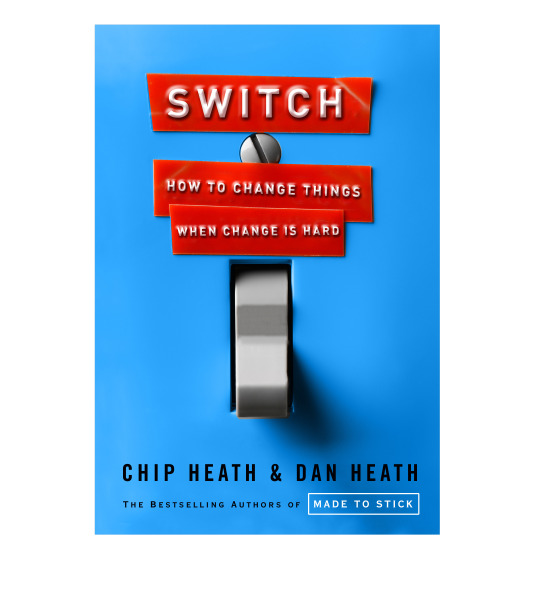
Source: Belmont
We’ve been using the ideas from the Health brothers to reflect on our challenges and ways of trying to create positive and measurable change. We typically review a chapter or two each week after doing stand-up.
A great book review by Sangeeth Varghese on Forbes.com highlights the main ideas of the book:
“The authors of Switch argue that change works best when each individual who begins a change or who leads changes focuses on three big things at once:
1. Motivate the elephant. The elephant is our emotional, instinctive side, which is lazy and skittish and will take any quick payoff over a long-term reward. We all have that. The elephant is usually the first cause of any failure to change, because the change we want usually involves short-term sacrifice in pursuit of long-term benefit. Think of any time you have chosen to oversleep or overeat or think about it tomorrow, and so on. You can’t get anywhere with any change effort unless you engage a person’s emotional side to get their lazy elephant to turn to the path of change.
2. Direct the rider. The rider, perched atop the elephant, is our rational side. We presume our rational side holds the reins and chooses the way forward. But the rider’s control is precarious, because he is tiny compared with the elephant. Whenever a six-ton elephant and a 150-pound rider disagree about where to go, the elephant wins. But often what looks like elephant resistance or rider weakness is really just lack of clarity. You must give the rider clear direction with which it can steer the elephant.
3. Shape the path. Change often fails because the rider can’t keep the elephant on the road long enough to reach the destination. The elephant’s hunger for instant gratification pulls against the rider’s strength, which is the ability to think big picture and plan beyond the moment. The more you can make straight and clear the path ahead, the more you can diminish confusion between elephant and rider and make progress for both of them easier and more likely, no matter what is going on between them.
The book also takes on what its authors consider to be popular myths about change. A big one is that we’ve constantly got to solve problems. When something is broken, we worry about how to fix it. We commonly bring in outside management experts to implement industry best practices. But people naturally resist solutions brought in from elsewhere, the authors say. They suggest looking for “bright spots” within the organization instead. Native solutions can often be found by asking a simple question: What is working, and how can we do more of it? That question may sound simple, but at most organizations it is never asked, the authors have found.”
It’d be great if after our SCIP pilot is done some of the participants use the book to start a leadership circle back in their service center. This would allow them to gather with others interested in spreading the “improvement movement” and to create a deeper sense of collegiality.
0 notes
Text
Improvement Movement Update
We have about six weeks left in our six-month Service Center Improvement Project (SCIP) at four service centers (three up and running and one being created). As of today, the group created 90 SMART plans (Specific, Measurable, Actionable, Relevant and Time-bound), completed 37 and of these, ten will be “ongoing” post-SCIP (e.g., keep making paper forms digital or implementing a better process to update information given to clients and staff).
The “completed” changes include building an “express line” and process for clients so those with certain needs don’t have to wait as long to be helped. This idea spread from one service center lobby to another. A separate program streamlined an internal process reducing the amount of time clients and employees wait for paperwork by two days.
Several projects have also focused on employee morale by creating spaces for coworkers and managers to recognize each others’ efforts and successes. There have also been projects promoting peer-to-peer learning and sharing data (e.g., number of clients helped, how many tasks employees completed, etc.) of program outcomes with more staff so that they can see the collective impact of their work.
When I asked the group about next steps after this pilot is done a common thread in their feedback was being allowed to continue making changes to improve clients’ and employees’ experiences. Such a response is a testament to the incredible group of folks who work at the Agency and want to see it do better.
Kind of makes me want to high-five everyone.

Source: Doctor Popular, High Fives on Market St, Flickr
1 note
·
View note
Text
The Rule of 5: A quick way to be more effective
When you’re creating something for others to use or interpret or read then consider showing it to the actual users, just five, different individuals at a time. The key is to learn from a variety of people. This is particularly important in the public sector, such as old and young and of various backgrounds, ethnicities as well as language, physical and cognitive abilities, etc. The purpose is for you to see if your actual users can understand and interact with whatever you create. Doing this early and often helps to catch mistakes quickly before the deadline is due for whatever you’re creating. The Rule of 5 can help you build a better thing/service/deliverable before having many more people use it.
Think of it as a mini-pilot or, if time permits, a series of mini-pilots.

Source: Victor, Flickr
The Rule of 5 requires five simple steps:
1) Start with one user at a time. Not in pairs or a group. Let your user know there are no wrong answers. You want their help to make whatever you’re creating for them better. Explain you have a handful of questions and it should only take a couple of minutes (if in fact that’s the case).
2)They talk 99% of the time and you/creators listen. No explanation for what you meant to say or do, just listen since you are not going to be there to explain every time anyone uses or interacts with whatever is being created.
3) Ask them/the users to “talk aloud whatever you’re thinking. Again, no wrong answers.” (Repeat this often, especially when there is silence.)
4) Once they’re done ask two final questions: “What is missing from this?” wait for their answer, then ask, “Is there anything else about this that you feel I should know?”
5) Use the feedback you learn from the first five to make improvements, then show another five individuals (one at a time), and repeat until the deadline calls.
As the researcher, Jakob Nielsen, who developed this guideline states:
“Elaborate usability tests are a waste of resources. The best results come from testing no more than 5 users and running as many small tests as you can afford.”
Nielsen goes on to provide a graph and states the following:

The point is that insights come out of observing and listening to people who will use whatever you’re creating. Consider the amount of time and effort saved in the future by not having to explain or redo or correct things repeatedly if what you create now is simple and clear. Plus, the impact of what you create will be greater since people will understand what to do. Send any thoughts to Marc (dot) Hebert (at) sfgov.org, thanks!
0 notes
Text
Service Design in HSA
This visual summarizes the approach we are taking to improve how clients and employees experience service delivery.
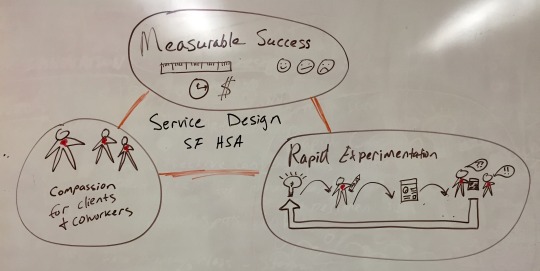
The authors of Scaling Up Excellence provide a visual (pg. 116) from the Design for Delight initiative @Intuit on which ours is based. We have gone through several iterations to communicate these ideas. This may be the new starting point to show our ideas before providing further details to coworkers interested in spreading the “Improvement Movement” across the Agency. Any feedback or ideas are welcome via email to Marc (dot) Hebert (at) sfgov.org.
2 notes
·
View notes
Text
Strategy: Unpacking the Improvement Movement in HSA
Someone stopped me in the hall the other day, and said how at her weekly office meeting a coworker had an idea to make an improvement and shared it with everyone. Apparently this coworker rarely, if ever, offers such suggestions and in the past when other improvements were shared this individual offered resistance. “Why the change?,” I asked my colleague.
The response was something along the lines of “I think the improvement movement is giving people permission to share [...] and to fail.”
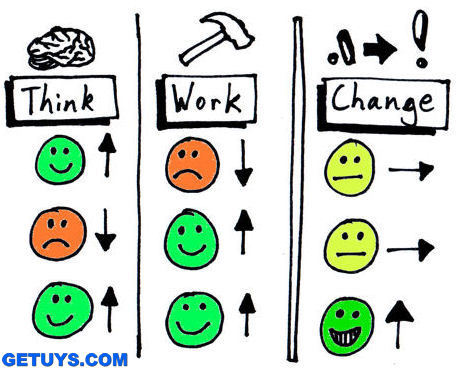
Source: Richard Stephenson, Flickr
Our strategy behind the Improvement Movement has been cobbled together by learning from leaders in the public sector innovation space. They work both domestically (largely in California) and internationally (Australia, Canada, and Denmark in particular); within and outside of government. Listservs, media outlets, reports, blogs and books have helped us for sure. Conferences, connections and just emailing folks who were willing to chat yielded great insights. These conversations allowed them to share their lessons learned with us.
We are indebted to colleagues in other Human Services Agencies (HSAs) who talked about their successes and failures in using Lean Process Improvement, Human-Centered Design or another approach to improve how clients and employees experience service delivery as well as program outcomes.
We've found patterns across their practices to innovate in government that overlap with the broader literature on this topic. These patterns are a framework for a strategy and an interpretive lens to reflect on why past initiatives succeeded or fizzled out.
The patterns we found are characteristics of successful initiatives for government agencies to "innovate" (yes, this word can be problematic, but work with us here). Our working definition of innovation = empathy + experimentation + measurable change. See below for a blog post that teases out each of these three.
We've narrowed our strategy for innovation to five attributes common in successful HSAs and other governmental entities that are larger and smaller in scale than SF HSA. They are align, organize, support, aspire and analyze. Let’s look at each of these.

Source: National Geographic
Align: Clarify the project’s or Agency’s north star or guiding light that is a shared sense of purpose understood, and preferably felt, by all employees. It's the reason we come to work that is beyond ourselves. It's describing the 'service' in "public service."
Examples: “Live Well” or “Every Person Matters” or “Dedicated to Making a Difference” or “Continuous Improvement” or *“Success Depends on Helping People to Comply...Rather than Catching Them Not Complying.”
Sources: The U.S. counties of Denver, Merced, San Diego, Santa Cruz, and the *Danish Ministry of Taxation.
We haven’t settled on anything Agency-wide, but for the Service Center Innovation Project (SCIP) we’re using the “Improvement Movement.”

Source: Oliver Degabriele, Flickr
Organize: Gather employees to champion the project/change from across programs and positions based on their past performance that demonstrates alignment with the North Star. Prepare them to champion the project by doing the following:
onboarding them to the change movement, creative/innovation process, goals and messaging (2 - 4 hours).
encourage them to improve the onboarding content, which makes it better, increases their buy in and adheres to the same collaborative process being championed.
co-create a presentation with them, and ask them to share it with everyone (groups of 20-30) in their respective program or service center. The presentation will help each employee across the organization or service center to understand the North Star, why change is happening, and how everyone can participate, measure success and be rewarded for it.
Sources: The U.S. counties of Merced, Olmsted and San Diego.

Source: Marina del Castell, Flickr
Support: Enable all employees to feel they can improve the client experience (CX) & employee experience (EX).
greenlight for improvements is simple and quick,
time to make improvements will depend on the situation, but “quick wins” are the initial focus (taking minutes, hours or a full day’s worth of time).
process to guide how improvements are made can be adapted to different contexts.
commitment to improvement by making it part of the organization culture (e.g., discussing it at regular meetings).
celebrate successes in meaningful ways to employees (i.e., rethinking the current reward structure).
Sources: The U.S. counties of Denver, Merced, Olmsted, Sacramento and San Diego.

Source: Bill Gracey, Flickr
Aspire: Define short-term, ambitious goals to channel people’s collective efforts while promoting the sharing of ideas across the organization, particularly around scaling up “bright spots.”
Examples: Support X number of employees with needed printers, copiers, computers and ergonomic considerations within Y amount of time OR champion X number of employees to learn and apply a process for continuous improvement in Y different agencies OR create leadership circles among X number of employees to facilitate professional and personal growth by Y of next year.
Sources: U.S. counties of Denver, Merced, Olmsted, and San Diego as well as the Regional Municipality of Durham, Canada.

Source: Enokson, Flickr
Analyze: Use data with empathy and as a learning opportunity to encourage improvements.
Examples:
Ongoing performance reviews and program metrics as helpful feedback to improve work processes and clients’ experiences.
Share program bright spots Agency-wide to cross-pollinate successes.
Prioritize program weak spots for innovative improvements based on program outcomes as well as client and employee feedback.
Sources: U.S. counties of Denver, Shasta and Ventura.
Align, organize, support, aspire and analyze are not the only characteristics. This list can be expanded or contracted, such as adding a technology/digital services component. Interestingly, among the five characteristics discussed here, four deal directly with human behavior, namely making sure employees are on the same page and feel supported.
The Deputy Executive Director of the American Public Human Services Association, Phil Basso, kindly reviewed the above and offered his feedback. First, he noticed the absence of partnership with clients, community-based organizations and other Agency stakeholders. He is right, but this partnership will come soon. We are working in phases, similarly as he pointed out, to the Human Services Value Curve that helps government agencies to become more effective by making incremental, structural improvements.
Our strategy is in the first phase of the “improvement movement” by starting with employees at all levels of service centers being able to create measurable change. This involves developing new processes and internal capacity as part of a “public sector innovation ecosystem” that includes closer collaboration with clients and community partners. It’s about “shaping the path” for employees to understand how they create improvements quickly and collaboratively. Their efforts are meant to develop a foundation and core group of champions who can spread and scale improvements far beyond their four dozen or so numbers to coworkers across the Agency.
The second piece of feedback Basso offered is that collectively this strategy speaks to “adaptive leadership.” It is a concept popularized by a professor of public leadership at Harvard's Kennedy School of Government, Ronald Heifetz. In essence, we are more effective when not responding to problems and interacting with others similarly, but adapting to situations, personalities, and problems based on the situation at hand. There are frameworks or a mindset that might help us to be more adaptive, in our case, it is a blend of design thinking and Agile/Lean Startup experimentation with a pinch of some other stuff.
Basso’s comments have been helpful and we welcome yours as well. Please send your thoughts or comments on this post to Marc (dot) Hebert (at) sfgov.org.
0 notes
Text
11th SCIP Meeting
Last week the Service Center Innovation Project (SCIP) group of non-managers met. Here are some of the projects on which they are working.
1) Created an express lane for clients at one of the the service centers to be helped faster based on what another service center has done successfully. These improvements have already demonstrated saved time for clients.
2) Reduce by one or two days it takes to do an internal process.
3) Create staff appreciation walls / “kudos boards” in different service centers so that co-workers, managers and those who report to supervisors can all express gratitude.
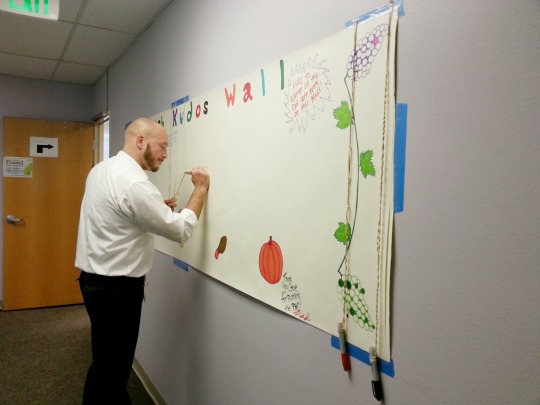
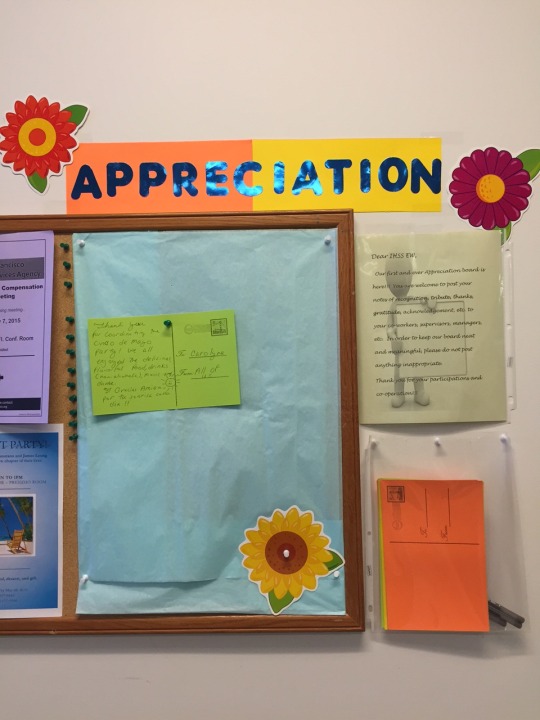
4) For a new service center being created by pulling together separate programs, they held an interactive meeting for employees to get everyone on the same page as they create a new culture by working together in new ways.

5) One service center is using the “accuracy rate” of employees to see areas in need of improvement in order to create workshops/refresher training.
0 notes
Text
8th-10th SCIP Meetings
The Service Center Innovation Project (SCIP) is finishing its third month of working with 48 people in seven different positions across our Agency’s service centers to improve clients’ and employees’ experiences.

Source: Frits Ahlefeldt-Laurvig, Flickr
Here’s an update: SCIP participants received a link to an anonymous feedback form. 17 of 48 people completed the five questions on the form and we have started making our own improvements.
Q1: How might we improve our SCIP meetings?
We heard that the weekly meetings feel rushed and there is not enough time for mangers and non-managers to interact. Suggested improvements included more time and direction from managers.
“Direction from managers” is tricky because managers want to hear the ideas of non-managers about what needs to be improved, and yet some non-managers seek more guidance. In response, our weekly meeting format will evolve.
Non-managers will continue to come every week for the full 90 minutes. This will allow them to focus on creating and implementing SMART plans/improvement. Non-managers will come every other week for 60 minutes.
Rather than SCIP participants working on all five ambitious goals each month, we plan to focus on two per month.

Source: Leland Francisco, Flickr
Q2: How could we better our improvement movement?
We heard that time is an issue for SCIP and non-SCIP participants. There is also a perception among some non-managers that their supervisors and managers may not be fully supportive of the improvement movement. Finally, there was an invitation from non-managers, who interact with clients on the phone or in person, to managers who don’t have these daily experiences to do so.
In response, the new Deputy Director for self-sufficiency/eligibility programs agreed to spend time in each of the service centers to understand how clients and staff experience service delivery with unemployment, food and health care assistance as well as county assistance to single adults.
We also provided clarity on allocating time to SCIP participants to attend the weekly meetings and to work on improvements. Supervisors of non-SCIP participants are also empowered to give time to their team to implement improvements.
Managers in SCIP were asked to make inquiries into improvements in their service centers at their weekly meetings with supervisors moving forward. This is something that needs follow up in future meetings.

Source: Wendy, Flickr
Q3: We are about two months into our six-month pilot. How well is the SCIP group meeting your expectations up to now on a scale from 1 (Not Very Successfully) to 10 (Very Successfully)
The average of the responses was 6.4 and the most common answer (the “mode” for data geeks) was 7. Four people put 7, fyi.
Q4: Why give your response to Q3?
We heard that not many improvements have been made and people don’t have enough time to make changes. To be fair, some also said that the changes are starting to take off. A list of improvements or SMART plans in the works will be posted here soon.
We also heard it is challenging to balance the time constraints many service center staff have with the space to make improvements. Better messaging to supervisors to create this time for their staff (depending on the proposed SMART plan) may be needed.
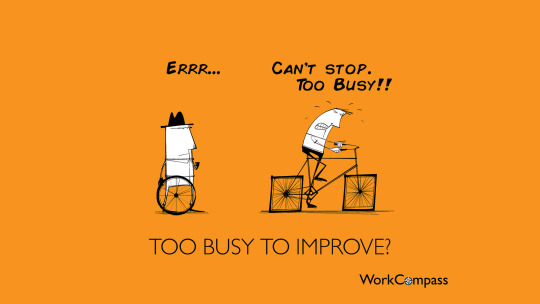
Source: Alan O'Rourke, Flickr
Q5: Please complete this sentence: "Overall, my SCIP experience has been like a ______, because ___________."
The dominant themes appear to be a sense of being rushed or a lack of direction or having hope/positive experiences. The changes mentioned previously, in part, address the sense of being rushed at our weekly meetings. The lack of direction; however, will be something we attempt to tackle head on at our next meeting.
The responses to this question are so rich that all 17 are included below.

bungie jump, not enough time to interpret what is expected and the rush of the meetings
whirlwind because I am still in the process of trying to juggle the little time we have aside to do the ambitious goal
accelerated meeting, b/c many ideas flow very rapidly

Source: GiGi_NYC, Flickr
Motivating, I honestly think and hope we can make positive changes that will improve the morale of employees and the efficiency of the service center.
roller coaster, no real direction
pleasant experience because it allows me the opportunity to hear experiences from other programs.
We really should have activities that bring staff from all over HSA together.
great experience I like being inspired by others and seeing how much change can happen with just a little motivation.

Source: Rune T, Flickr
mystery, because I don't know the role I am to play.
positive change, ideas that are shared to make improvements
I'm learning different ways to assist with our processes
massage because it relaxes constraints enough to let more positive things come in
an outlet because it lets us experiment ideas
Strong Cup of Coffee; I have become energized, and focused in on areas where we can make quick improvements while actively working towards our lofty long term goals.
eye-opening because of shared concern about management.

Source: John Christopher, Flickr
wonderful one because we need more programs like this to help get all the innovation and excitement out of people.
Overall, my SCIP experience as been great because sharing ideas with other programs/buildings on what is working (and not working) helps a lot as well as learning about challenges that they face.
a wake up call and an opportunity to implement positive changes and improve morale. Because I am excited about having this privilege and interested in generating ideas on a smaller scale and then on a large scale.
0 notes
Text
6th & 7th SCIP Meetings
SCIP = Service Center Innovation Project
SCIP is about a shift in our organizational culture towards making quick improvements in an experimental and collaborative way. Improves focus on clients’ and employees’ experiences as well as our program mandates/requirements. Learning from our mistakes is part of this process that champions the creativity of HSA employees in our service centers.
At our last two meetings, we clarified the metrics for success regarding the ambitious goals of the SCIP team (i.e., nearly 50 people from about dozen different programs and offices who represent seven different positions).

Source: Xavier Jamonet via Charlie Stinchcomb, Flickr
Ambitious Goals & How We Plan to Measure Them
Improve client satisfaction/experience by 25%: Measured by the County Welfare Directors Association (CWDA) Client Experience (CE) Survey. We plan to use a version of this survey.
Reduce lobby wait time by 25%: Each part of the Client Experience that is currently measured will be used.
Reduce phone wait times/dropped calls by 25%: We currently measure this.
Improve employee morale/appreciation by 25%: The All Staff Survey has questions which we will use to measure employee morale and appreciation.
Improve employee learning/training/skills by 25%: The All Staff Survey will help us here as well.
The group agreed that if we move the needle of success by trying to achieve these ambitious goals, then we should also reduce the number of pending tasks.

Source: Ian Sane, Flickr
Rollout of the Improvement Movement
SCIP team members are presenting to everyone in their service centers about the movement and a process to make small, quick improvements over the next five months. The SCIP team is doing this by sharing the same presentation and handout with peers in groups of 20-40.
There are certain themes in the feedback SCIPers are getting from their colleagues. One is having colleagues initially think of SCIP as a giant, human, suggestion box rather than an organized way to empower everyone in service centers to create and experiment with making quick improvements.
Another theme in the feedback from co-workers is wondering if this movement is really a committed effort from our Agency’s leadership or is it just “the flavor of the month.” Quick successes/improvements are the surest way of showing rather than telling our colleagues this improvement movement is for real.

Source: Frits Ahlefeldt-Laurvig, hikingartist.com, Flickr
SMART Plans
At our meeting last week, the SCIP non-managers created plans to make quick improvements. These plans were Specific, Measurable, Actionable, Relevant and Time-bound (SMART) (George T. Dora, Management Review, November 1981). They shared these plans with the managers at the meeting, and we agreed to spend week eight (this week) working to implement the plans rather than come to our meeting. We plan to see their outcomes next week. Two SCIP participants already shared their SMART plan with me. I’m optimistic. Feel free to share any questions or comments with marc (dot) hebert (at) sfgov.org.
0 notes